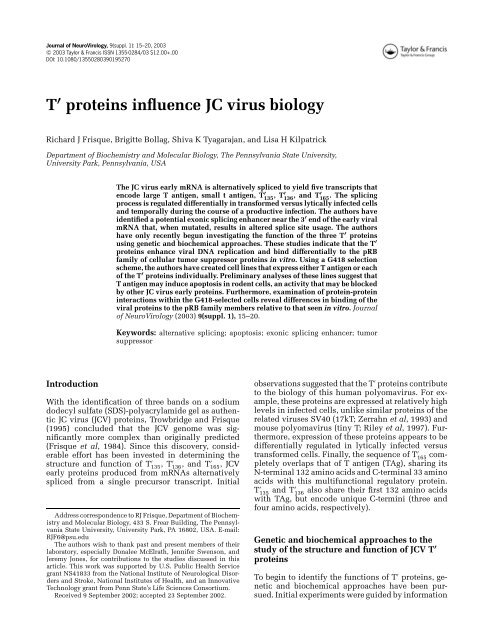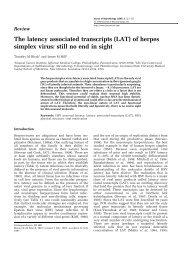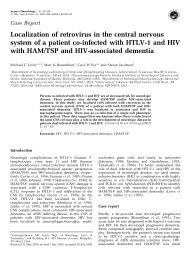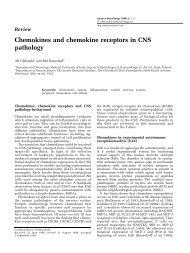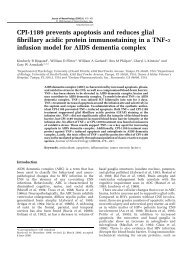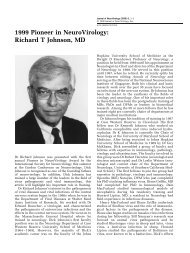PDF (213 KB) - Informa Healthcare
PDF (213 KB) - Informa Healthcare
PDF (213 KB) - Informa Healthcare
Create successful ePaper yourself
Turn your PDF publications into a flip-book with our unique Google optimized e-Paper software.
Journal of NeuroVirology, 9(suppl. 1): 15–20, 2003<br />
c○ 2003 Taylor & Francis ISSN 1355-0284/03 $12.00+.00<br />
DOI: 10.1080/13550280390195270<br />
T ′ proteins influence JC virus biology<br />
Richard J Frisque, Brigitte Bollag, Shiva K Tyagarajan, and Lisa H Kilpatrick<br />
Department of Biochemistry and Molecular Biology, The Pennsylvania State University,<br />
University Park, Pennsylvania, USA<br />
The JC virus early mRNA is alternatively spliced to yield five transcripts that<br />
encode large T antigen, small t antigen, T ′ 135 ,T′ 136 , and T′ 165 . The splicing<br />
process is regulated differentially in transformed versus lytically infected cells<br />
and temporally during the course of a productive infection. The authors have<br />
identified a potential exonic splicing enhancer near the 3 ′ end of the early viral<br />
mRNA that, when mutated, results in altered splice site usage. The authors<br />
have only recently begun investigating the function of the three T ′ proteins<br />
using genetic and biochemical approaches. These studies indicate that the T ′<br />
proteins enhance viral DNA replication and bind differentially to the pRB<br />
family of cellular tumor suppressor proteins in vitro. Using a G418 selection<br />
scheme, the authors have created cell lines that express either T antigen or each<br />
of the T ′ proteins individually. Preliminary analyses of these lines suggest that<br />
T antigen may induce apoptosis in rodent cells, an activity that may be blocked<br />
by other JC virus early proteins. Furthermore, examination of protein-protein<br />
interactions within the G418-selected cells reveal differences in binding of the<br />
viral proteins to the pRB family members relative to that seen in vitro. Journal<br />
of NeuroVirology (2003) 9(suppl. 1), 15–20.<br />
Keywords: alternative splicing; apoptosis; exonic splicing enhancer; tumor<br />
suppressor<br />
Introduction<br />
With the identification of three bands on a sodium<br />
dodecyl sulfate (SDS)-polyacrylamide gel as authentic<br />
JC virus (JCV) proteins, Trowbridge and Frisque<br />
(1995) concluded that the JCV genome was significantly<br />
more complex than originally predicted<br />
(Frisque et al, 1984). Since this discovery, considerable<br />
effort has been invested in determining the<br />
structure and function of T ′ 135 ,T′ 136 , and T′ 165 , JCV<br />
early proteins produced from mRNAs alternatively<br />
spliced from a single precursor transcript. Initial<br />
Address correspondence to RJ Frisque, Department of Biochemistry<br />
and Molecular Biology, 433 S. Frear Building, The Pennsylvania<br />
State University, University Park, PA 16802, USA. E-mail:<br />
RJF6@psu.edu<br />
The authors wish to thank past and present members of their<br />
laboratory, especially Donalee McElrath, Jennifer Swenson, and<br />
Jeremy Jones, for contributions to the studies discussed in this<br />
article. This work was supported by U.S. Public Health Service<br />
grant NS41833 from the National Institute of Neurological Disorders<br />
and Stroke, National Institutes of Health, and an Innovative<br />
Technology grant from Penn State’s Life Sciences Consortium.<br />
Received 9 September 2002; accepted 23 September 2002.<br />
observations suggested that the T ′ proteins contribute<br />
to the biology of this human polyomavirus. For example,<br />
these proteins are expressed at relatively high<br />
levels in infected cells, unlike similar proteins of the<br />
related viruses SV40 (17kT; Zerrahn et al, 1993) and<br />
mouse polyomavirus (tiny T; Riley et al, 1997). Furthermore,<br />
expression of these proteins appears to be<br />
differentially regulated in lytically infected versus<br />
transformed cells. Finally, the sequence of T ′ 165 completely<br />
overlaps that of T antigen (TAg), sharing its<br />
N-terminal 132 amino acids and C-terminal 33 amino<br />
acids with this multifunctional regulatory protein.<br />
T ′ 135 and T′ 136 also share their first 132 amino acids<br />
with TAg, but encode unique C-termini (three and<br />
four amino acids, respectively).<br />
Genetic and biochemical approaches to the<br />
study of the structure and function of JCV T ′<br />
proteins<br />
To begin to identify the functions of T ′ proteins, genetic<br />
and biochemical approaches have been pursued.<br />
Initial experiments were guided by information
JC virus T ′ protein function<br />
16 RJ Frisque et al<br />
already available for JCV TAg. Numerous functional<br />
domains influencing viral DNA replication and oncogenic<br />
behavior are localized within the region of overlap<br />
between TAg and the T ′ proteins. Using a sitedirected<br />
mutagenesis approach, the shared donor or<br />
the three unique acceptor T ′ splice sites were altered<br />
to eliminate expression of one, two, or all three T ′ proteins.<br />
These mutant genomes were transfected into<br />
permissive human fetal glial cells, and it was demonstrated<br />
that the loss of all three T ′ proteins resulted in<br />
a 10- to 20-fold reduction in DNA replication activity<br />
(Trowbridge and Frisque, 1995; Prins and Frisque,<br />
2001). It was also determined that mutation of the<br />
T ′ 135 acceptor splice site led to the use of cryptic sites<br />
resulting in the appearance of new T ′ species.<br />
To assess the transforming potential of the T ′ proteins,<br />
initial work examined their ability to interact<br />
with the tumor suppressor protein, pRB, and its related<br />
family members, p107 and p130. TAg, T ′ 135 ,<br />
T ′ 136 , and T′ 165 , purified from insect cells infected with<br />
recombinant baculoviruses, were mixed with extracts<br />
of human MOLT-4 cells containing pRB-related proteins.<br />
Each viral protein was found to interact with<br />
the hypophosphorylated forms of pRB, p107, and<br />
p130 in this in vitro assay (Bollag et al, 2000). Importantly,<br />
the JCV proteins exhibited differential binding<br />
to the pRB family members. Recent models suggest<br />
that in addition to binding pRB family members<br />
through their LXCXE domain, polyomavirus tumor<br />
proteins must effect the release of E2F transcription<br />
factors found in complex with these family members<br />
(Sheng et al, 1997; Sullivan et al, 2000, 2001).<br />
The viral proteins, via their J domain, interact with<br />
Hsc70, a molecular chaperone protein, to effect this<br />
release. Using extracts of POJ cells expressing all<br />
five JCV early proteins and an immunoprecipitationimmunoblotting<br />
assay, at least one of the JCV proteins<br />
was shown to bind Hsc70 in vivo. Recent experiments<br />
involving Rat 2 cell lines expressing individual JCV<br />
early proteins (see below) revealed that T ′ 135 interacts<br />
with Hsc70. This result is in contrast to that reported<br />
for an N-terminal truncated form of SV40 TAg, called<br />
N136, that fails to form a stable complex with the<br />
molecular chaperone (Sullivan et al, 2001).<br />
Functional analyses of T ′ proteins expressed<br />
in G418-selected cells<br />
the<br />
To investigate T ′ protein function further, we have<br />
used a G418 selection protocol to create rat and<br />
mouse cell lines expressing one or more JCV early<br />
proteins (Kilpatrick, Bollag, McElrath, and Frisque,<br />
manuscript in preparation). During the initial isolation<br />
of these lines, an observation was made that may<br />
be relevant to the question of viral protein function.<br />
Rat 2 fibroblasts were transfected with constructs<br />
containing either the intact JCV early coding region<br />
or individual TAg, T ′ 135 ,T′ 136 or T′ 165 cDNAs under<br />
control of the cytomegalovirus (CMV) promoter.<br />
Cell lines expressing all five JCV proteins or each T ′<br />
protein independently were readily established by<br />
single-cell cloning following G418 selection. In lines<br />
established with the TAg cDNA plasmid, both TAg<br />
and the T ′ proteins were produced, presumably because<br />
the TAg cDNA retains the T ′ splice sites. To<br />
eliminate expression of T ′ mRNAs and proteins by<br />
the TAg cDNA, the T ′ donor splice site was mutated,<br />
and the altered construct was transfected into Rat 2<br />
cells. Upon G418 selection, only a single line expressing<br />
TAg in the absence of the other early proteins<br />
could be isolated. TAg was expressed at relatively low<br />
levels in these cells, and sequence analysis indicated<br />
that the integrated TAg gene encoded a wild-type protein.<br />
Preliminary experiments utilizing mouse NIH-<br />
3T3 cells have yielded similar results. One interpretation<br />
of these data is that TAg induces apoptosis in<br />
the rodent cells, and that T ′ proteins and/or small t<br />
protein (tAg) block this activity. It should be noted<br />
that SV40 TAg and tAg may have proapoptotic or<br />
antiapoptotic activities depending upon experimental<br />
conditions (Gjoerup et al, 2001 and references<br />
therein).<br />
The G418-selected lines expressing different JCV<br />
proteins have been assessed for cell-doubling time<br />
and for saturation density in medium supplemented<br />
with 1% or 10% fetal bovine serum (Kilpatrick et al,<br />
manuscript in preparation). Growth parameters of<br />
cloned, independent lines expressing all five early<br />
proteins together or TAg and T ′ proteins individually<br />
were compared to the parental Rat 2 line and to a JCVtransformed<br />
line isolated from a dense focus assay.<br />
Two G418-selected lines expressing the intact JCV<br />
early region exhibited accelerated growth rates and<br />
elevated saturation densities, although these transformation<br />
phenotypes did not attain the levels exhibited<br />
by the control transformed line. Cells producing<br />
a single viral protein (either TAg, T ′ 135 ,T′ 136 ,orT′ 165 )<br />
displayed growth parameters only slightly elevated<br />
above those of the Rat 2 parental line; by these criteria<br />
they did not appear to be transformed. Earlier<br />
studies indicated that most G418-selected cells expressing<br />
JCV early proteins fail to exhibit an aggressive<br />
transformed phenotype, presumably because expression<br />
levels of the tumor proteins fail to attain a<br />
required threshold necessary for complete transformation<br />
(Trowbridge and Frisque, 1993). It might be<br />
important to analyze a larger number of independent<br />
cell lines and assess a wider range of growth parameters<br />
to understand the contribution of T ′ proteins to<br />
the transformation process.<br />
Availability of the G418-selected Rat 2 lines has<br />
permitted us to examine in vivo interactions between<br />
individual JCV early proteins and the pRB family<br />
of proteins (Kilpatrick et al, manuscript in preparation).<br />
Lysates of these cells were immunoprecipitated<br />
with antibodies specific either for pRB, p107, and<br />
p130 or for JCV early proteins. Complexes were electrophoresed<br />
on polyacrylamide gels and subjected to
JC virus T ′ protein function<br />
RJ Frisque et al 17<br />
Western blot analysis using anti-pRB, anti-p107, or<br />
anti-p130 antibodies. p107 from the parental Rat 2<br />
cells migrated as a doublet; but in cells expressing all<br />
five JCV early proteins or cells containing T ′ 135 or T′ 165<br />
alone, only the band with the greater mobility was detected.<br />
It was this hypophosphorylated form of p107<br />
to which the viral proteins bound. In cells expressing<br />
TAgorT ′ 136 , we failed to observe an interaction between<br />
the viral proteins and p107. In addition, p107<br />
from these cells included the hyperphosphorylated<br />
form. The second pRB family member, p130, was<br />
found to exist as multiple phosphorylated forms in<br />
the parental cells and in the line expressing TAg only.<br />
In the latter cells, TAg did not form a complex with<br />
p130. In cells expressing all five JCV early proteins<br />
or cells producing T ′ 135 ,T′ 136 ,orT′ 165 , hypophosphorylated<br />
p130 was the most prominent form. Again, it<br />
was this fastest migrating band with which the viral<br />
proteins interacted. Because pRB was present at low<br />
levels in these cell lines, we were unable to convincingly<br />
demonstrate an in vivo interaction between it<br />
and the viral proteins.<br />
Our in vivo and in vitro binding assays yielded different<br />
results in regard to the ability of TAg and T ′ 136<br />
to bind p107 and p130. At this time we are unable to<br />
explain the discrepancy involving the ability of T ′ 136<br />
to form a complex with p107. Two different cell lines<br />
were examined, and T ′ 136 failed to bind p107 in both<br />
instances. It is possible that T ′ 136 recognizes differences<br />
between human p107 in the MOLT-4 extracts<br />
and rat p107 in the Rat 2 cells. Alternatively, the two<br />
opposing outcomes may reflect differences in the concentrations<br />
of proteins used in the in vitro and in vivo<br />
experiments. In the case of TAg, its inability to bind<br />
p107 and p130 in vivo may reflect its reduced level<br />
of expression in the only cell line available for examination.<br />
Alternatively, this result could signal the<br />
possibility that a nonfunctional TAg is expressed in<br />
the G418-selected Rat 2 cells (although the integrated<br />
gene is not mutated). If, as we have suggested, TAg induces<br />
programmed cell death in Rat 2 cells, then one<br />
might speculate that our G418 approach selected for<br />
a cell expressing a TAg defective in this, and perhaps<br />
other (e.g., p107 and p130 binding), activities.<br />
Regulation of alternative splicing of the JCV<br />
early mRNA<br />
The process of alternative splicing that yields the<br />
transcripts encoding the five JCV early proteins is regulated<br />
by both cis-acting signals and trans-acting factors.<br />
The SR family of cellular proteins plays important<br />
roles in splice site selection. Regulation of their<br />
expression and function is influenced by cell type<br />
and post-translational modification, respectively (reviewed<br />
in Elliot, 2000; Lopez, 1998; Xiao and Manley,<br />
1997). SR proteins bind to short sequences in the<br />
RNA called exonic splicing enhancers (ESEs) and<br />
may antagonize the activity of other splicing factors<br />
by competing for binding to overlapping recognition<br />
sites (reviewed in Lopez, 1998). Interactions between<br />
SR proteins and ESEs may lead to the recruitment of<br />
additional splicing factors that enhance splicing at<br />
suboptimal 3 ′ acceptor sites (reviewed in Blencowe,<br />
2000; Zheng et al, 1997). Mutations introduced into<br />
ESEs have a wide range of effects on splicing patterns,<br />
suggesting that sequence context and position<br />
contribute to ESE function (Liu et al, 2000). A number<br />
of viruses have exploited the process of alternative<br />
splicing to enhance viral multiplication. For example,<br />
during the course of an infection, adenovirus<br />
regulates the activity of one or more SR proteins<br />
(Kanopka et al, 1998; Molin and Akusjärvi, 2000) to<br />
alter its own splicing program, and thus the proteins<br />
it produces. In the case of SV40, TAg alters the relative<br />
proportions of splice variants of TEF-1, a cellular<br />
transcription factor that influences SV40 promoter<br />
activity (Zuzarte et al, 2000).<br />
Splicing of the JCV early precursor mRNA is regulated.<br />
Early observations revealed that T ′ 136 is the<br />
only T ′ protein produced in significant amounts<br />
in transformed rat fibroblasts, whereas all three T ′<br />
proteins are readily detected in JCV-infected human<br />
fetal glial cells (Trowbridge and Frisque, 1995).<br />
Reverse transcriptase–polymerase chain reaction<br />
(RT-PCR) analysis of T ′ transcripts produced in a lytic<br />
infection versus a variety of transformed and tumor<br />
cells indicates that the differential splicing patterns<br />
are not due to the tissue or species origin of the cells,<br />
but rather to differences in the lytic versus transformed<br />
state (Jones and Frisque, unpublished data).<br />
In a second set of experiments, we observed that<br />
splicing is temporally regulated during the course of<br />
a lytic infection (Prins, Jones, and Frisque, unpublished<br />
data). At day 3 post infection (p.i.), the pattern<br />
of T ′ mRNA splicing resembled that seen in the<br />
transformed cells in the first experiment (i.e., the T ′ 136<br />
transcript was the most abundant mRNA detected).<br />
By day 7 p.i., however, the lytic pattern of splicing,<br />
as seen in the initial RT-PCR experiment, became apparent<br />
(i.e., all three T ′ transcripts were produced at<br />
similar levels). One could hypothesize that these two<br />
examples of regulated splicing are related. Late gene<br />
expression does not occur in JCV-transformed cells or<br />
in lytically infected cells before approximately day<br />
5 p.i. It is possible that one or more late viral proteins<br />
alter the initial splicing program.<br />
Several years ago our group, while examining<br />
cells transformed by a series of JCV TAg mutants,<br />
made an observation that could not be explained<br />
by information then available. Mutations had been<br />
introduced near the C-terminus of TAg in an attempt<br />
to identify potential phosphorylation sites<br />
(Swenson and Frisque, 1995; JJ Swenson, PhD thesis,<br />
The Pennsylvania State University, 1995). Cells expressing<br />
the mutant TAgs were labeled with [ 35 S]-<br />
methionine, lysates were prepared and immunoprecipitated<br />
with an anti-T antibody, and complexes
JC virus T ′ protein function<br />
18 RJ Frisque et al<br />
Figure 1 Altered T ′ protein expression in cells expressing mutant JCV TAgs. Extracts of cells expressing JCV or SV40 early proteins<br />
labeled with [ 35 S]-methionine were immunoprecipitated with PAb 416, a monoclonal antibody that recognizes an epitope shared by<br />
TAg and the three T ′ proteins. The immune complexes were electrophoresed on an SDS-polyacrylamide gel and protein bands were<br />
visualized by fluorography. The positions of the JCV and SV40 TAgs, the three JCV T ′ proteins, and the cellular tumor suppressor protein,<br />
p53, to which each TAg binds, are noted. Lanes labeled T664A, T664S, E666A, and E666S represent independent cell lines containing<br />
four different JCV TAgs mutated at amino acid position 664 or 666 (Swenson and Frisque, 1995). Note that only the lines expressing<br />
the wild-type (lane JCV) or T664A TAg produce detectable levels of T ′ 165 (T′ 165<br />
migrates as a doublet due to differential phosphorylation).<br />
Furthermore, in the T664A line, T ′ 165<br />
appears to be expressed at higher levels relative to the other JCV early proteins (compare the relative<br />
amounts of T ′ in lane 4 versus 3). Finally, lane E666S 165 a represents a second cell line containing the E666S TAg mutant, but in these cells<br />
JCV early protein expression is altered more extensively; all three T ′ proteins are missing and the mobility of TAg is shifted.<br />
were electrophoresed on an SDS-polyacrylamide gel.<br />
The observed pattern of early protein expression was<br />
unexpected; in most lines, T ′ 165 was not readily detected,<br />
and in some cloned lines expressing mutant<br />
E666S, all three T ′ proteins were absent and the mobility<br />
of TAg was shifted (Figure 1; data not shown).<br />
Upon reexamination of these results recently, we<br />
noted that the mutated sequence resembles a consensus<br />
binding site for the alternative splicing factor,<br />
ASF/SF2 (Figure 2; Tacke and Manley, 1995).<br />
Of the four mutants examined, only T664A contains<br />
an alteration that converts the JCV sequence to one<br />
more closely resembling an ASF/SF2 site. A cell line<br />
expressing this mutant produces all three T ′ proteins,<br />
and T ′ 165 expression appears to be elevated relative<br />
to the other viral proteins. Changes in the other<br />
three mutants all result in JCV sequences that diverge<br />
from the potential ESE, and cells expressing<br />
these mutants fail to produce T ′ 165 . Two of 11 lines expressing<br />
E666S, which alters the predicted ASF/SF2<br />
binding site at two positions, fail to produce any T ′<br />
proteins and the mobility of TAg is altered. ASF/SF2<br />
acts upon proximal 3 ′ splice sites that include a suboptimal<br />
polypyrimidine tract. The potential ESE discussed<br />
here is located adjacent to the T ′ 165 3′ splice<br />
site that is associated with a weak polypyrimidine<br />
tract. We have now constructed two mutants in this<br />
potential ESE, transfected them into Rat 2 cells, isolated<br />
G418-resistant cell lines, and examined early<br />
protein expression patterns (Tyagarajan and Frisque,<br />
unpublished data). The alteration in the consensus<br />
mutant changes the relevant JCV sequence to a
JC virus T ′ protein function<br />
RJ Frisque et al 19<br />
Figure 2 The 3 ′ end of the JCV early mRNA contains a potential<br />
ESE. A tandem duplication of a consensus ASF/SF2 binding site<br />
(Tacke and Manley, 1995) is shown at the top of the figure. Such<br />
sites might function as exonic splicing enhancers or ESEs. The JCV<br />
sequence from nucleotides 2684 to 2669 (the T ′ 165<br />
acceptor site is<br />
at nucleotide 2704) encodes a portion of the C-terminal region<br />
of TAg and is shown below the consensus ASF/SF2 binding site.<br />
Differences between the two sequences are underlined. One- or<br />
two-nucleotide changes were introduced into the JCV sequence to<br />
create the four TAg mutants identified in Figure 1. Note that the<br />
change in T664A (A to G) creates a JCV sequence more similar to<br />
that of the AFS/SF2 site, whereas the other three mutations create<br />
sequences that are less similar (T664S, A to T; E666A, A to C;<br />
E666S, GA to TC).<br />
duplicated ASF/SF2 consensus site; preliminary results<br />
indicate this mutant yields a wild-type expression<br />
pattern. Changes in the nonconsensus mutant<br />
create a JCV sequence predicted to further disrupt<br />
the ASF/SF2 binding site; it does not alter proteincoding<br />
information. Preliminary results indicate that<br />
cells containing this mutant express reduced levels<br />
of T ′ proteins.<br />
In summary, we have shown that the JCV T ′ proteins<br />
interact with the pRB family of proteins both<br />
in vitro and in vivo, and that JCV TAg, T ′ 135 ,T′ 136 ,<br />
and T ′ 165 exhibit differential binding activities. In<br />
addition, T ′ 135 binds to the DnaK protein, Hsc70,<br />
in vivo. These interactions indicate the J and LXCXE<br />
domains in TAg and T ′ proteins are functional, and<br />
that each of these proteins might influence cell-cycle<br />
progression and transforming potential through the<br />
release of the E2F family of transcription factors. Furthermore,<br />
interactions between JCV T ′ proteins and<br />
Hsc70 could be responsible for the positive effects T ′<br />
proteins have upon JCV DNA replication. This suggestion<br />
is supported by earlier studies with SV40 TAg<br />
and this molecular chaperone (Campbell et al, 1997).<br />
We suggest that T ′ proteins and/or tAg might also<br />
influence JCV biology by interfering with an apoptotic<br />
function of TAg. This speculation rests upon our<br />
inability to readily isolate rodent cell lines only expressing<br />
TAg and upon the documented effects SV40<br />
early proteins have on apoptosis. Experiments now<br />
in progress will attempt to confirm that our observations<br />
involve programmed cell death. Furthermore,<br />
because our findings have been made in nonpermissive<br />
rodent cells, it will be important to determine<br />
whether this activity is also displayed in permissive<br />
human glial cells.<br />
Alternative splicing of the JCV immature early<br />
mRNA is regulated temporally during the course of<br />
an infection. In addition, JCV early splicing patterns<br />
in transformed cells resemble those seen early in a<br />
lytic infection, but differ from patterns seen late in<br />
infected cells. It is possible that the function and/or<br />
expression levels of splicing factors remain stable in<br />
the transformed cell, but change in the lytically infected<br />
cell as late viral proteins are produced. These<br />
cellular factors bind to ESEs, cis-acting regulatory<br />
signals in the mRNA, to influence splicing patterns.<br />
We believe we have identified one such ESE near<br />
the 3 ′ end of the JCV early mRNA, and we predict<br />
that the SR protein, ASF/SF2, binds this sequence<br />
and regulates the selection of the T ′ acceptor splice<br />
sites.<br />
References<br />
Blencowe BJ (2000). Exonic splicing enhancers: mechanism<br />
of action, diversity and role in human genetic diseases.<br />
Trends Biochem Sci 25: 106–110.<br />
Bollag B, Prins C, Snyder EL, Frisque RJ (2000). Purified<br />
JC virus T and T ′ proteins differentially interact with<br />
the retinoblastoma family of tumor suppressor proteins.<br />
Virology 274: 165–178.<br />
Campbell KS, Mullane KP, Aksoy IA, Stubdal H, Zalvide<br />
J, Pipas JM, Silver PA, Roberts TM, Schaffhausen BS,<br />
DeCaprio JA (1997). DnaJ/hsp40 chaperone domain of<br />
SV40 large T antigen promotes efficient viral DNA replication.<br />
Genes Dev 11: 1098–1110.<br />
Elliot DJ (2000). Splicing and the single cell. Histol<br />
Histopathol 15: 239–249.<br />
Frisque RJ, Bream GL, Cannella MT (1984). Human polyomavirus<br />
JC virus genome. J Virol 51: 458–469.<br />
Gjoerup O, Zaveri D, Roberts TM (2001). Induction of p53-<br />
independent apoptosis by simian virus 40 small t antigen.<br />
J Virol 75: 9142–9155.<br />
Kanopka A, Muhlemann O, Petersen-Mahrt S, Estmer C,<br />
Ohrmalm C, Akusjärvi G (1998). Regulation of adenovirus<br />
alternative RNA splicing by dephosphorylation<br />
of SR proteins. Nature 393: 185–187.<br />
Liu HX, Chew SL, Cartegni L, Zhang MQ, Krainer AR<br />
(2000). Exonic splicing enhancer motif recognized by<br />
human SC35 under splicing conditions. Mol Cell Biol<br />
20: 1063–1071.<br />
Lopez AJ (1998). Alternative splicing of pre-mRNA: developmental<br />
consequences and mechanisms of regulation.<br />
Annu Rev Genet 32: 279–305.<br />
Molin M, Akusjärvi G (2000). Overexpression of essential<br />
splicing factor ASF/SF2 blocks the temporal shift in adenovirus<br />
pre-mRNA splicing and reduces virus progeny<br />
formation. J Virol 74: 9002–9009.<br />
Prins C, Frisque RJ (2001). JC virus T ′ proteins encoded by<br />
alternatively spliced early mRNAs enhance T antigen–<br />
mediated viral DNA replication in human cells. J<br />
NeuroVirol 7: 250–264.
JC virus T ′ protein function<br />
20 RJ Frisque et al<br />
Riley MI, Yoo W, Mda NY, Folk WR (1997). Tiny T antigen:<br />
An autonomous polyomavirus T antigen aminoterminal<br />
domain. J Virol 71: 6068–6074.<br />
Sheng Q, Denis D, Ratnofsky M, Roberts TM, DeCaprio<br />
JA, Schaffhausen B (1997). The DnaJ domain of polyomavirus<br />
large T is required to regulate RB family tumor<br />
suppressor function. J Virol 71: 9410–9416.<br />
Sullivan CS, Cantalupo P, Pipas JM (2000). The molecular<br />
chaperone activity of simian virus 40 large T antigen is<br />
required to disrupt Rb-E2F family complexes by an ATPdependent<br />
mechanism. Mol Cell Biol 20: 6233–6243.<br />
Sullivan CS, Gilbert SP, Pipas JM (2001). ATP-dependent<br />
simian virus 40 T-antigen-Hsc70 complex formation.<br />
J Virol 75: 1601–1610.<br />
Swenson JJ, Frisque RJ (1995). Biochemical characterization<br />
and localization of JC virus large T antigen phosphorylation<br />
domains. Virology 212: 295–308.<br />
Tacke R, Manley JL (1995). The human splicing factors<br />
ASF/SF2 and SC35 possess distinct, functionally significant<br />
RNA binding specificities. EMBO J 14: 3540–3551.<br />
Trowbridge PW, Frisque RJ (1993). Analysis of G418-<br />
selected Rat2 cells containing prototype, variant, mutant,<br />
and chimeric JC-virus and SV40 genomes. Virology<br />
196: 458–474.<br />
Trowbridge PW, Frisque RJ (1995). Identification of three<br />
new JC virus proteins generated by alternative splicing<br />
of the early viral mRNA. J NeuroVirol 1: 195–206.<br />
Xiao SH, Manley JL (1997). Phosphorylation of the<br />
ASF/SF2 RS domain affects both protein-protein and<br />
protein-RNA interactions and is necessary for splicing.<br />
Genes Dev 11: 334–344.<br />
Zerrahn J, Knippschild U, Winkler T, Deppert W (1993).<br />
Independent expression of the transforming aminoterminal<br />
domain of SV40 large T-antigen from an alternatively<br />
spliced third SV40 early messenger RNA.<br />
EMBO J 12: 4739–4746.<br />
Zheng ZM, He PJ, Baker CC (1997). Structural, functional,<br />
and protein binding analyses of bovine papillomavirus<br />
type 1 exonic splicing enhancers. J Virol 71: 9096–<br />
9107.<br />
Zuzarte PC, Farrance IK, Simpson PC, Wildeman AG<br />
(2000). Tumor cell splice variants of the transcription<br />
factor TEF-1 induced by SV40 T-antigen transformation.<br />
Biochim Biophys Acta 1517: 82–90.


